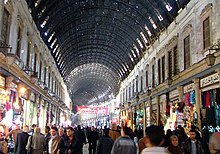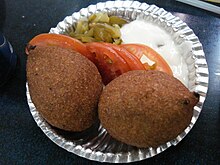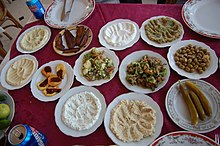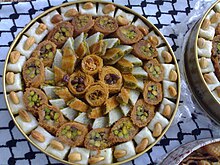Syrian cuisine
As Syrian cuisine ( Arabic مطبخ سوري) refers to both the cuisine of the state of Syria and the Syrian landscape , which today is largely identical to the state territory west of the Euphrates . It is a regional cuisine of Arabic cuisine with influences from the former ruling Ottoman Empire with its Turkish, Kurdish and Armenian culture in the north and the cuisine of the Levant on the Mediterranean coast with its cultural and religious diversity.
description
The dishes of the Syrian cuisine are closely related to the dishes of the regions from southern Jordan to Lebanon , from the West Bank to the Euphrates . These regions east of the Mediterranean are known as the Levant . For centuries, the Levant was a transit area for foreign rulers and traders, who strongly shaped the kitchen traditions. Different cultures settled in Syria and influenced the Syrian cuisine. During and after the end of the Islamic era under the Umayyad family clan , Arab influences were decisive. After that, Persian influences gained importance under the Abbasid dynasty . The Turkish cuisine was more firmly established in Syria as the Ottomans gained power.
The Levante cuisine is characterized by an aromatic, light way of cooking. The Levante cuisine, which has become a food trend in Europe, is characterized by a lot of vegetables and little meat. The Levantine influences on Syrian cuisine are reflected in the aromatic spices, diverse vegetables and legumes.
Cooking is done every day in Syrian households. Dining out is restricted to special occasions. The traditional main meal is prepared from fresh ingredients and eaten together with the family for lunch. The fruit used mostly comes from their own garden or from irrigated fields. Three courses make up the typical main meal. The first course consists of one or more starters. This is followed by the main course with lean meat or vegetables and side dishes such as rice, bulgur and flatbread . Finally, a dessert, such as sesame or semolina biscuits, is served.
Seasonal character
Syrian cuisine shows a strong seasonal character. In the past, agriculture and livestock were the main livelihoods of the population. Therefore, the cultivated agricultural products as well as dairy products and meat were used in the kitchen. Each season offers different ingredients. In spring, green, wild plants such as thyme , dandelion , mallow and mint are used to prepare typical spring dishes. Various herbs, chickpeas, grape leaves and beans are also harvested in spring. The lush and fat pastures of spring provide the basis for cream cheese, yoghurt and butter. The summer dishes use the many varieties of fruit, vegetables and herbs. Tomatoes, cucumbers, okra pods (marshmallow), kidney beans as well as watermelons , cactus fruits and apricots are used in the kitchen at this time. The wheat harvest takes place in summer. The autumn dishes use the harvest of grapes, corn, olives and nuts. Quinces , pumpkins and apples are processed during this time of the year. For the winter dishes, fruit, vegetables, cereals, legumes, drinks and dairy products were preserved (preserved) in the other seasons. Onions and olive oil are needed all year round . Olive oil was already used in Syrian cuisine 5,000 years ago. The use of spices and fresh herbs is the essence of the kitchen.
Regional particularities
The geographical location within the different regions of Syria influences the kitchen dishes and is the cause of many regional specialties. In the Mediterranean area, fish dishes are more important than in mountain regions. Agriculture and cattle breeding are distributed differently in Syria. In the coastal and river landscapes as well as in mountain regions, arable farming is increasingly being practiced. The Bedouins lead as shepherds their flocks in the seasonal cycle and according to the weather conditions from place to place. The kitchen is adapted to the regional and seasonal conditions. In winter, the Bedouins spend most of their time in the desert regions and migrate to the cultivated land and mountain regions in the warmer months. In the mountains, game meat enriches the kitchen alongside fresh ingredients. In the regions with increased cattle breeding, beef and sheep dishes as well as dairy products determine the kitchen tradition.
Food
The main ingredients of Syrian cuisine are wheat , chickpeas , olives , tomatoes , apricots , pomegranates , dates and figs . Mint , coriander , parsley , cardamom , cinnamon , saffron , sesame and cumin are used for seasoning . The meat used in the preparation is mainly lamb and poultry, in the coastal areas also fish. As in all Muslim countries, pork is neither processed nor eaten, but garlic , onions and olive oil are plentiful .
The groceries are bought fresh every day. Most shops specialize in one type of food, some bakeries even specialize in individual baked goods, for example flatbread, others in European or Oriental-style pastries, the latter often very sweet and garnished with pistachios . Often, for reasons of cost, unprocessed, uncleaned food is bought in large quantities that have to be processed at home.
In addition, markets offer fruit and vegetables from the region, as well as meat and bread. Long-life foods such as rice or flour are bought in supermarkets. Frozen foods are rarely used in Syrian cuisine. Purchased pita bread is served as an accompaniment to the dishes, and in rural areas home-baked flatbread, the khobz altenor .
In the coastal regions, mate tea is often drunk with meals.
breakfast
As in many other countries, coffee or black tea with sugar is taken for breakfast in Syria. You can also eat flatbread with ful medammas , olives, musabbaha (a chickpea porridge ), but also jam or cheese. Well-known types of cheese are Halloumi , Akkawi , Belady or Meshallala . A typical breakfast dish is ta'miyya (cherry pea balls in flatbread), which are offered early in the morning in food stalls. But eggs, cooked as an egg dish or omelette, are also eaten for breakfast.
Many Syrian families eat pizza-like flatbreads ( manakish) topped with thyme, cheese or minced meat as a late breakfast on the weekend . The shaped dough can be bought in many bakeries in the Levant .
Having lunch
Lunch is eaten between 1 p.m. and 4 p.m. in the Syrian kitchen, preferably with the family. Lunch consists of several courses, including soups and starters, as well as a dessert. The preferences for the main course are different. They range from yoghurt with meat and onions, the alshakerih , to kibbeh ( bulgur dumplings with minced meat and onions) to kebab dairy (pita bread filled with particularly spicy meat). Rice or bulgur are usually eaten as a side dish.
At lunchtime, many food stalls offer so-called Fatayir . These are filled dumplings, but also shawarma or chicken skewers, the shish tavuk .
dinner
Dinner falls between 7 and 10 p.m. It can be prepared as a light meal and then contains ingredients similar to breakfast, but it can also be hearty and filling. Depending on preference and region, a warm meal is consumed at least once a day, but it can also be freshly cooked twice.
Dinner, which is the actual main meal, begins with various mezze . These small dishes can be creamy pastes like hummus and eggplant puree, are served over grilled or pickled vegetables with yogurt sauce, or dipped with bread from a shared plate. Fresh salads made from tomatoes, wheat and chopped parsley, the tabboule , are also among the starters.
The main course is mostly grilled meat, the Mashawi , also chopped, from chicken or beef, with fresh onions, parsley or grilled tomatoes as side dishes; also stuffed zucchini or eggplant , casserole, meatballs in tomato sauce, the Dawud Pasha . Another dish typical of Syrian cuisine are okra pods cooked in tomato sauce , Arabicبامية / 'Bamya'.
Starters (mezze)
Syrian cuisine is characterized by a multitude of hot and cold starters. These are served at the beginning of every Syrian meal. In addition to salads and nuts, 40-50 small starters, known as mezze, are often served in the middle of the table at social events. Typical starters are fattusch , hummus and tabbouleh . The mezze tradition, which began during the Ottoman Empire, is alive throughout the Levant. The type of mezze dishes varies greatly both seasonally and regionally. Mezze with fish are common in the marine regions. In the mountains, on the other hand, mezze dishes are mainly served with meat. Fresh salads and summer fruits are typical starters in summer.
Fattusch
Fattusch (Fattoush) is a Syrian salad dish with toasted flatbread. The bread salad consists of mint, parsley, ice lettuce leaves, tomatoes, cucumber and diced flatbread. It is prepared with pomegranate molasses . The dish is an expression of the healthy Syrian food culture.
Hummus
The creamy sauce made from finely pureed chickpeas and sesame paste (tahini) is one of the Syrian national dishes.
Tabbouleh
The bulgur salad is one of the classics from the Arab world. The light salad has also become popular in Europe. The Syrian tabbouleh variation is prepared with more parsley and less bulgur.
Desserts
In addition to baklava , which are served homemade, kunafa (strudel dough baked in strings), filled with cheese or nuts and coated with syrup, are popular in Syrian cuisine . The preparation of the desserts is very complex, so they are usually bought in specialty shops that offer cakes, sweets and other desserts.
Ice cream is very popular and is traditionally mixed with mastic , which gives the cream a tougher consistency than conventional ice cream.
fruit
Typical types of fruit in Syrian cuisine are: pears, figs, cherries, oranges, lemons, peaches, apricots, quinces, grapes, water melons or other melons, pomegranates and medlars .
beverages
Sweetened tea is drunk in abundance at any time of the day. Coffee is served on many occasions such as visiting friends, weddings, business meetings or funerals, where the coffee powder is boiled with sweetened water.
Sparkling water is often drunk with dishes, but also fruit juices such as orange, pomegranate or lemon juice, the latter with fresh mint (limun bina'na ). Like Turkish cuisine, Syrian cuisine also knows Ayran , a drink made from yogurt , water and salt . In the markets (Aswaq) there are stalls with cold beverages made from tamarind (Tamar Hindi) or liquorice juice made from liquorice , depending on the season.
Arak is common for alcoholic beverages . This is often served as an aperitif with starters.
literature
- Fadi Alauwad: Hayati: Syrian local cuisine: A culinary journey through the Orient. Edition Michael Fischer / EMF Verlag, 2017, ISBN 978-3-86355-837-6 .
- Jwan Joo Daod: As a guest of friends: 12 stories and recipes from Syria. Edible paper edition, 2015, OCLC 950619790 .
- Rafik Schami, Marie Fadel: Damascus - The Taste of a City. Insel Verlag, 2016, ISBN 978-3-458-35887-9
Web links
Individual evidence
- ↑ a b c d Viola Raheb , Marwan Abado : Time of the figs: Arab cuisine from Bethlehem to Damascus . Almond Tree, 2009, ISBN 978-3-85476-301-7 .
- ↑ Syria; culture, history and civilization. syriahistory.weebly.com, accessed October 28, 2018 .
- ↑ Katja Wallrafen: Variety shapes the Levante cuisine. Frankfurter Neue Presse, October 10, 2018, accessed on October 28, 2018 .
- ↑ Sarah Backhaus: Kitchen from the Levant. Chefkoch GmbH, accessed October 28, 2018 .
- ↑ a b c d Fadi Alauwad: Hayati: Syrian local cuisine: A culinary journey through the Orient . Edition Michael Fischer / EMF Verlag, 2017, ISBN 978-3-86355-837-6 , p. 9 .
- ↑ a b Viola Raheb, Marwan Abado: Time of the figs: The Arab cuisine from Bethlehem to Damascus . Mandelbaum, 2009, ISBN 978-3-85476-301-7 , p. 18-19 .
- ^ Coleman South, Leslie Jermyn, Kelly Spence: Syria: Third edition. Cavendish Square Publishing: 2016, p. 215.
- ↑ a b c d e Syrian cuisine: A brief introduction by Jwan Joo Daod - Edible paper edition . In: Edition Esspapier . 2016 ( editionesspapier.com ).
- ↑ The Yerba Mate year in numbers on mate-blog.de, accessed on November 3, 218
- ^ History of Yerba Mate in Middle East Countries on arar.com, accessed November 3, 2018.
- ↑ Yassin Musharbash: Send the cat home. Zeit Magazin, March 19, 2016, accessed October 27, 2018 .
- ↑ a b Katja Brinkmann: Syria: between Damascus, Palmyra, Aleppo and the Euphrates. Treschner Verlag, 2011, p. 93f online on Google Books (accessed on October 26, 2018)
- ↑ Nadia Zerouali and Merijn Tol: Souq: From mezze to pistachio cake - the Orient tastes so delicious . ZS Verlag GmbH, Hamburg 2018, ISBN 978-3-89883-749-1 , p. 5-6 .
- ↑ Fadi Alauwad: Hayati: Syrian Homeland Cuisine: A Culinary Journey Through the Orient . Edition Michael Fischer / EMF Verlag, 2017, ISBN 978-3-86355-837-6 , p. 33 .
- ↑ Malakeh Jazmati: Malakeh: Longing recipes from my Syrian homeland . ZS Verlag GmbH, Munich 2019, ISBN 978-3-89883-656-2 , p. 11 .
- ↑ Fadi Alauwad: Hayati: Syrian Homeland Cuisine: A Culinary Journey Through the Orient . Edition Michael Fischer / EMF Verlag, 2017, ISBN 978-3-86355-837-6 , p. 29 .
- ↑ Elizabeth Whitman: In Pictures: Syrian food finds Jordanian home. Beloved Syrian ice cream, shawerma and sweets shops have sprung up across Jordan to the delight of locals. , AlJazeera English, Sept 12, 2014; available online, last accessed on January 24, 2020
- ↑ a b Fadi Alauwad: Hayati: Syrian home cooking: A culinary journey through the Orient . Edition Michael Fischer / EMF Verlag, 2017, ISBN 978-3-86355-837-6 , p. 13 .
- ^ Syria: Food & Drink. 7o7 MARKETING GmbH, accessed on December 9, 2018 .
- ↑ Would you have thought that this is how coffee is drunk in these 10 countries? FOCUS Online, accessed December 9, 2018 .
- ^ Sari Edelstein: Food, Cuisine, and Cultural Competency for Culinary, Hospitality, and Nutrition Professionals. Boston, 2011 p. 577








